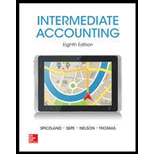
(1)
Stock options: Stock options are the stock-based compensation plans provided in the form of an option to buy certain number of shares for a certain price during certain period.
To determine: The compensation cost of stock options
(1)
Explanation of Solution
Compute the total compensation cost of stock options.
(2)
Debit and credit rules:
- Debit an increase in asset account, increase in expense account, decrease in liability account, and decrease in
stockholders’ equity accounts. - Credit decrease in asset account, increase in revenue account, increase in liability account, and increase in stockholders’ equity accounts.
To journalize: The entry for compensation expense on December 31, 2016, in the books of Corporation WAV
(2)
Explanation of Solution
Prepare journal entry for compensation expense on December 31, 2016.
| Date | Account Titles and Explanation | Post Ref. | Debit ($) | Credit ($) | |
| 2016 | |||||
| December | 31 | Compensation Expense | 20,000,000 | ||
| Paid-In Capital–Stock Options | 20,000,000 | ||||
| (To record compensation expense) | |||||
Table (1)
- Compensation Expense is an expense account. Since expenses decrease stockholders’ equity, and a decrease in stockholders’ equity is debited.
- Paid-in Capital–Stock Options is a stockholders’ equity account. Since stock options are considered as earned by the employee, stockholders’ equity increased, and an increase in equity is credited.
Working Notes:
Compute the compensation cost allocated each year.
Note: Refer to Equation (1) for the value and computation of compensation cost.
(3)
To journalize: The entry for compensation expense on December 31, 2017, in the books of Corporation WAV
(3)
Explanation of Solution
Prepare journal entry for compensation expense on December 31, 2017.
| Date | Account Titles and Explanation | Post Ref. | Debit ($) | Credit ($) | |
| 2017 | |||||
| December | 31 | Compensation Expense | 20,000,000 | ||
| Paid-In Capital–Stock Options | 20,000,000 | ||||
| (To record compensation expense) | |||||
Table (2)
- Compensation Expense is an expense account. Since expenses decrease stockholders’ equity, and a decrease in stockholders’ equity is debited.
- Paid-in Capital–Stock Options is a stockholders’ equity account. Since stock options are considered as earned by the employee, stockholders’ equity increased, and an increase in equity is credited.
Note: Refer to Equation (2) for the value and computation of compensation expense.
(4)
To journalize: The options exercised in the books of Corporation WAV
(4)
Explanation of Solution
Journalize the entry for options exercised in the books of Corporation WAV.
| Date | Account Titles and Explanation | Post Ref. | Debit ($) | Credit ($) | |
| 2018 | |||||
| March | 12 | Cash | 240,000,000 | ||
| Paid-in Capital – Stock Options | 30,000,000 | ||||
| Common Stock | 30,000,000 | ||||
| Paid-in Capital–Excess of Par | 240,000,000 | ||||
| (To record purchase option exercised by stock option holders) | |||||
Table (3)
- Cash is an asset account. Since cash is received, asset value increased, and an increase in asset is debited.
- Paid-in Capital–Stock Options is a stockholders’ equity account. Since stock options are exercised and shares are issued, stock options value is decreased, and a decrease in equity is debited.
- Common Stock is a stockholders’ equity account. Since stock options are exercised and shares are issued, common stock value increased, and an increase in equity is credited.
- Paid-in Capital–Excess of Par is a stockholders’ equity account. Since stock options are exercised and shares are issued, excess of par value increased, and an increase in equity is credited.
Working Notes:
Compute cash received by Corporation WAV.
Compute the paid-in capital of stock options amount.
Compute the common stock amount.
Compute the paid-in capital–excess of par amount.
Note: Refer to Equations (3), (4), and (5) for all the values.
(5)
To journalize: The expired options before being exercised in the books of Corporation WAV
(5)
Explanation of Solution
Journalize the entry for expired options in the books of Corporation WAV.
| Date | Account Titles and Explanation | Post Ref. | Debit ($) | Credit ($) | |
| 2022 | |||||
| December | 31 | Paid-in Capital–Stock Options | 10,000,000 | ||
|
Paid-in Capital–Expiration of Stock Options | 10,000,000 | ||||
| (To record expiry of option unexercised) | |||||
Table (4)
- Paid-in Capital–Stock Options is a stockholders’ equity account. Since stock options are exercised and shares are issued, stock options value is decreased, and a decrease in equity is debited.
- Paid-in Capital–Expiration of Stock Options is a stockholders’ equity account. Since stock options are expired before being exercised, this account is credited to close the unexercised stock options.
Working Notes:
Compute the paid-in capital–expiration of stock options amount.
Note: Refer to Equation (4) for value and computation of paid-in capital of exercised options.
Want to see more full solutions like this?
Chapter 19 Solutions
INTERMEDIATE ACCOUNTING WITH AIR FRANCE-KLM 2013 ANNUAL REPORT

 AccountingAccountingISBN:9781337272094Author:WARREN, Carl S., Reeve, James M., Duchac, Jonathan E.Publisher:Cengage Learning,
AccountingAccountingISBN:9781337272094Author:WARREN, Carl S., Reeve, James M., Duchac, Jonathan E.Publisher:Cengage Learning, Accounting Information SystemsAccountingISBN:9781337619202Author:Hall, James A.Publisher:Cengage Learning,
Accounting Information SystemsAccountingISBN:9781337619202Author:Hall, James A.Publisher:Cengage Learning, Horngren's Cost Accounting: A Managerial Emphasis...AccountingISBN:9780134475585Author:Srikant M. Datar, Madhav V. RajanPublisher:PEARSON
Horngren's Cost Accounting: A Managerial Emphasis...AccountingISBN:9780134475585Author:Srikant M. Datar, Madhav V. RajanPublisher:PEARSON Intermediate AccountingAccountingISBN:9781259722660Author:J. David Spiceland, Mark W. Nelson, Wayne M ThomasPublisher:McGraw-Hill Education
Intermediate AccountingAccountingISBN:9781259722660Author:J. David Spiceland, Mark W. Nelson, Wayne M ThomasPublisher:McGraw-Hill Education Financial and Managerial AccountingAccountingISBN:9781259726705Author:John J Wild, Ken W. Shaw, Barbara Chiappetta Fundamental Accounting PrinciplesPublisher:McGraw-Hill Education
Financial and Managerial AccountingAccountingISBN:9781259726705Author:John J Wild, Ken W. Shaw, Barbara Chiappetta Fundamental Accounting PrinciplesPublisher:McGraw-Hill Education





